Burma Schools, Medicine, Sound & Travel
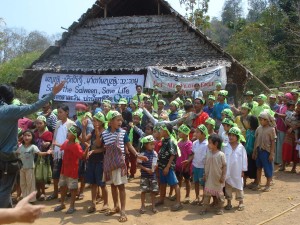
Karen children sing in honor of rivers: www.internationalrivers.org
BURMESE MIGRANT EDUCATION COMITEE
Burma, officially the Union of Myanmar, is the largest country by geographical area in Indochina (mainland Southeast Asia). The country is bordered by China on the north-east, Laos on the east, Thailand on the south-east, Bangladesh on the west, India on the north-west and the Bay of Bengal to the south-west with the Andaman Sea defining its southern periphery. One-third of Burma’s total perimeter, 1,930 kilometres (1,199 mi), forms an uninterrupted coastline. Read More: > HERE <
PRISONED NOBEL LAUREATES: Aung San Suu Kyi , born 19 June 1945) is a Burmese opposition politician and a former General Secretary of the National League for Democracy. She has remained under house arrest in Myanmar for almost 14 out of the past 20 years. Aung San Suu Kyi was the recipient of the Rafto Prize and the Sakharov Prize for Freedom of Thought in 1990 and the Nobel Peace Prize in 1991. In 1992 she was awarded the Jawaharlal Nehru Award for International Understanding by the Government of India. Read More: > Here <
Liu Xiaobo (pronunciation: [ljǒʊ̯ ɕjɑ̀ʊ̯pɔ́]; born 28 December 1955) is a Chinese literary critic, professor, and human rights activist who called for democratic reforms and the end of one-party rule in China. He is currently incarcerated as a political prisoner in China. During his 4th prison term, he was awarded the 2010 Nobel Peace Prize, for „his long and non-violent struggle for fundamental human rights in China. Read More: > HERE <
The Karen Teacher Working Group (KTWG) is a local Karen organization attempting to promote education throughout Karen State, Burma despite almost 60 years of Burma Army oppression.
You can find regularly updated news about Karen communities in refugee camps in Thailand and in internally displaced communities throughout Karen State, Burma – as well as news about schools in those communities. You can also find reports, newsletters, Karen fonts, and other resources on our site. Donations for Karen State schools may also be made online or by contacting us. For over half a century, civil war in Burma has uprooted many Ethnic, Indigenous communities. The Burmese military regime (SPDC) have focused their military offensives upon Ethnic groups living in the border areas of Burma . Numerous Ethnic Peoples have fled Burma to escape forced labour, re-location, rape, murder, theft and many other human rights abuses.
The Karen are one of the Ethnic groups from Burma . There are over 120,000 Karen living in refugee camps in Thailand . The majority of Karen live in Karen State, Burma where they continue to suffer greatly at the hands of the Burmese military regime (SPDC). There are over 100,000 internally displaced Karen persons living in Karen State, Burma.
AUNG SAN SUU KYI – Nobel Peace Prize Winner on Non Violence
Nobel Peace prize winners (Archbishop Desmond Tutu, The Dalai Lama, Shirin Ebadi, Adolfo Pérez Esquivel, Mairead Corrigan, Rigoberta Menchú, Prof. Elie Wiesel, U.S. President Barack Obama, Betty Williams, Jody Williams and former U.S. President Jimmy Carter) have called for the rulers of Burma to release Suu Kyi „create the necessary conditions for a genuine dialogue with Daw Aung San Suu Kyi and all concerned parties and ethnic groups in order to achieve an inclusive national reconciliation with the direct support of the United Nations.“
The Mae Tao Clinic (MTC), founded and directed by Dr. Cynthia Maung, provides free health care for refugees, migrant workers, and other individuals who cross the border from Burma to Thailand. People of all ethnicities and religions are welcome at the Clinic. Its origins go back to the student pro-democracy movement in Burma in 1988 and the brutal repression by the Burmese regime of that movement. The fleeing students who needed medical attention were attended in a small house in Mae Sot. Located on the border in Mae Sot, people of all ethnicities and religions are welcome at the Clinic.
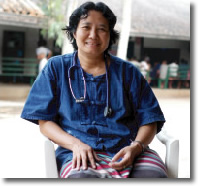
Since 1989 the Mae Tao Clinic has grown, from that one small house to a large complex of simple buildings that provide a wide variety of health services to different groups of people. Today it serves a target population of approximately 150,000 on the Thai-Burma border. Exact numbers are hard to calculate because of the fluidity of the population. About 50% of those who come to MTC for medical attention are migrant workers in the Mae Sot area; the other 50% travel cross-border from Burma for care.
Mae Tao Clinic Objectives: To provide health services for displaced Burmese populations along the Thailand-Burma border, initial training of health workers and subsequent corollary medical education, strengthen health information systems along the border, improve health, knowledge, attitudes, and practices within local Burmese populations, promote collaboration among local ethnic health organizations, strengthen networking and partnering with international health professionals and institutions.
The Nobel Women’s Initiative was established in 2006 by sister Nobel Peace Laureates Jody Williams, Shirin Ebadi, Wangari Maathai, Rigoberta Menchú Tum, Betty Williams and Mairead Corrigan Maguire. We six women — representing North and South America, Europe, the Middle East and Africa — decided to bring together our extraordinary experiences in a united effort for peace with justice and equality. Only 12 women in its more than 100 year history have been recognized with the Nobel Peace Prize. The Nobel Peace Prize is a great honor, but it is also a great responsibility. It is this sense of responsibility that compelled us to create the Nobel Women’s Initiative to help strengthen work being done in support of women’s rights around the world – work often carried out in the shadows with little recognition.
www.tutu.org Archbishop Tutu´s Birthday wishes to Aung San Suu Kyi
We believe peace is much more than the absence of armed conflict. Peace is the commitment to equality and justice; a democratic world free of physical, economic, cultural, political, religious, sexual and environmental violence and the constant threat of these forms of violence against women indeed against all of humanity.
The Vision of the Nobel Women’s Initiative is a world transformed, a nonviolent world of security, equality and well-being for all. It is the heartfelt mission of the Nobel Women’s Initiative to work together as women Nobel Peace Prize Laureates to use the visibility and prestige of the Nobel prize to promote, spotlight, and amplify the work of women’s rights activists, researchers, and organizations worldwide addressing the root causes of violence, in a way that strengthens and expands the global movement to advance nonviolence, peace, justice and equality. We accomplish this mission through three main strategies: convening, shaping the conversation, and spotlighting and promoting.
- www.nobelwomensinitiative.org
- Meet Free Liu Xiaobo, friends, fans at facebook <
- Meet International Rivers, friends, fans at facebook <
- Meet COP16, friends, fans, at facebook <
3rd Annual Atlanta Tibetan Festival
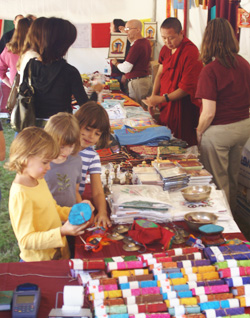
Drepung Monastery (wylie: ‚bras spungs dgon),(literally “Rice Heap” monastery), located at the foot of Mount Gephel, is one of the „great three“ Gelukpa university monasteries of Tibet. The other two are Ganden and Sera. Drepung is the largest of all Tibetan monasteries and is located on the Gambo Utse mountain, 5 kilometers from the western suburb of Lhasa. Freddie Spencer Chapman reported, after his 1936-37 trip to Tibet, that Drepung was at that time the largest monastery in the world, and housed 7,700 monks, „but sometimes as many as 10,000 monks.“ Read More: > Here <
The Gelug or Gelug-pa (or dGe Lugs Pa, dge-lugs-pa, or Dgelugspa), also known as the Yellow Hat sect, is a school of Buddhism founded by Tsongkhapa (1357–1419), a philosopher and Tibetan religious leader. The first monastery he established was at Ganden, and to this day the Ganden Tripa is the nominal head of the school, though its most influential figure is the Dalai Lama. Read more: > HERE <
Emory University is a private research university located in the metropolitan Atlanta area of Druid Hills, Georgia. The university was founded as Emory College in 1836 in Oxford, Georgia by a small group of Methodists and was named in honor of John Emory, a well-known Methodist bishop. Read More: > HERE <
Since His Holiness the Dalai Lama blessed our center in 2007, Drepung Loseling has been working towards completing its vision of creating a “Little Tibet” in Atlanta. Last year’s Tibetan Festival was voted by the Atlanta Journal Constitution as “The Top Thing to do”. Hundreds of visitors have enjoyed the last two festivals and we promise this year’s program will be just as fun.
Bring your family and friends to this special celebration of Tibetan culture. Activities include meditation, Tibetan food, music, dance, games, a Tibetan Bazaar, children’s arts and crafts, door prizes, a raffle and a live performance and workshop presented by the monks of the Mystical Arts of Tibet.
3rd Annual Atlanta Tibetan Festival
Saturday, November 6, 2010 – 10 am to 4 pm
Come and join us for our annual Tibetan Festival. There will be Tibetan food, music and dance, a Tibetan market along with guided meditation and games for the children.
The Mission of Drepung Loseling – Following the legacy of Drepung Loseling Monastery, India, and with the patronage of His Holiness the Dalai Lama, Drepung Loseling is dedicated to the study and preservation of the Tibetan Buddhist tradition of wisdom and compassion. A center for the cultivation of both heart and intellect, it provides a sanctuary for the nurturance of inner peace and kindness, community understanding, and global healing.
In implementing this vision, Drepung Loseling has two main objectives: To contribute to North American culture by providing theoretical knowledge and practical training in Tibetan Buddhist scholarly traditions for Western students, scholars and the general public; and To help preserve the endangered Tibetan culture, which today leads a fragile existence in the exiled refugee communities in India and Nepal.
Sponsor A Monk – The Drepung Loseling Educational Fund was established in 1988 to preserve traditional Tibetan culture by sponsoring a monk in training at Drepung Loseling.
Over half of our population is comprised of recent refugees whose parents remain in Chinese occupied Tibet; therefore, they cannot provide them with support. We also have a number of young monks who are orphans.
The Drepung Loseling Educational Fund was established in 1988 to preserve traditional Tibetan culture by sponsoring a monk in training at Drepung Loseling. Conditions in the Tibetan refugee camps in India are basic, and the average family is poor.
Young monks born in India have little parental support, and depend almost entirely upon the production of our small farm. Over half of our population is comprised of recent refugees whose parents remain in Chinese occupied Tibet; therefore, they cannot provide them with support. We also have a number of young monks who are orphans.
The Monastery accepts all sincere candidates regardless of their financial situation and must support them by means of the proceeds of the same small parcel of land provided to the original 216 Loseling refugee monks. The Fund helps provide for the basic needs of food, health care and education for these monks.
His Holiness formally accepts professorship: His Holiness the XIV Dalai Lama serves as Presidential Distinguished Professor, the first university appointment accepted by the 1989 Nobel Peace Laureate and leader of the Tibetan people. This appointment gives students unique access to His Holiness, his teachings and his insights. The Emory-Tibet Partnership raises awareness of Emory University as a leading center of study of Tibetan philosophy and religion in the West with both Western-trained and traditionally trained scholars.
The Affiliation with Emory University – The May 1998 visit of His Holiness the Dalai Lama marked the historic culmination of three years of dialogue and planning. While visiting Emory University in 1995, he was approached by a faculty delegation to discuss the prospects of an affiliation between Drepung Loseling Monastery and Emory University. In response to his positive interest, the affiliation process was initiated. During these discussions it was decided that the best infrastructure for this arrangement would be a direct affiliation of Emory University with Drepung Loseling Monastery in India, as well as with Drepung Loseling, Drepung’s North American seat. This would allow Drepung Loseling to design various programs both in North America and in India for academic accreditation through Emory. With this precedent-setting partnership, Drepung Loseling provides a unique link between the resources and faculty of a major American university and principal scholastic Tibetan monastery-in-exile in India.
Benares Gharana Music Concerts Austria
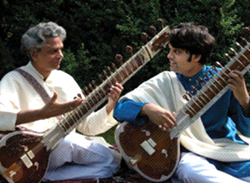
Varanasi (Sanskrit: वाराणसी VÄ�rÄ�ṇasÄ�)is a city situated on the banks of the River Ganges in the Indian state of Uttar Pradesh, 320 kilometres (199 mi) southeast of state capital Lucknow. It is regarded as a holy city by Buddhists and Jains, and is the holiest place in the world in Hinduism (and center of earth in Hindu Cosmology). It is one of the oldest continuously inhabited cities in the world and probably the oldest of India. The Kashi Naresh (Maharaja of Kashi) is the chief cultural patron of Varanasi and an essential part of all religious celebrations.The culture of Varanasi is closely associated with the River Ganges and the river’s religious importance. The city has been a cultural and religious centre in North India for several thousand years.
The Benares Gharana form of Indian classical music developed in Varanasi, and many prominent Indian philosophers, poets, writers, and musicians resided or reside in Varanasi, including Kabir, Ravidas Their Guru Swami Ramanand, Trailanga Swami, Munshi Premchand, Jaishankar Prasad, Acharya Shukla, Ravi Shankar, Girija Devi, Hariprasad Chaurasia, and Bismillah Khan. Tulsidas wrote Ramacharitamanas here, and Gautama Buddha gave his first sermon at Sarnath located near Varanasi (Kashi). Varanasi is home to four universities: Banaras Hindu University, Mahatma Gandhi Kashi Vidyapeeth, Central Institute of Higher Tibetan Studies and Sampurnanand Sanskrit University. Residents mainly speak Hindi and Kashika Bhojpuri, which is closely related to the Hindi language. People often refer to Varanasi as „the city of temples“, „the holy city of India“, „the religious capital of India“, „the city of lights“, and „the city of learning.“ Read More: > HERE <
Seit mittlerweile sieben Generation musizieren Vater und Sohn der Mishra Familie – Pandit Shivanth und Deobrat Mishra – gemeinsam. Music of Benares bringen mit Ihrer Musik den Zauber der mehr als 2000 Jahre alten Tradition der Sitar und Tabla zu uns.Ihre Musik lebt überwiegend von der Improvisation und folgt dem Ausdrucksreichtum der menschlichen Stimme. Deobrath Mishra wurde mehrmals als bester Sitarspieler Indiens ausgezeichnet.
Freitag 29.10.2010, Galerie Werkstatt NUU, www.nuu.at , Gesangs/Sitar oder Tabla Workshop mit Deobrath Mishra nach tel. Vereinbarung am 1, 2 und 3. November unter 0699 19429921 möglich!
Samstag 30.10.2010, 19 Uhr: Minoriten Kloster Tulln www.minoriten.at The Sound of India – Music from Benares, Shivnath & Deobrath Mishra, Sithar, Meister der klassischen indischen Musik, Festsaal/Klubräume – Eingang Nibelungenplatz. http://weltladen-tulln.at Weltladen Tulln: Wir feiern! Der Weltladen Tulln ist 5 Jahre alt geworden! Wir feiern gemeinsam mit den Vereinen Rainbowtrust (10 Jahre alt) und Miteinander leben (20 Jahre alt).
Gharana is a traditional style and way of teaching and performing Indian classical music. This style is many hundreds of years old and has been passed from master to student, from generation to generation. There are many Gharanas or styles, one of the most prominent ones being the Benaras Gharana. It is also called Varanasi Gharana. Over the years, the Benaras Gharana has produced many outstanding vocal, instrumental and dance performers.Like many traditions, this method of performing music and the great Indian cultural heritage, in general, have been threatened due to the lack of dedicated teachers and students.
A very rare Video clip of three generation’s of master musicians performing on same stage. Concert in Tulln-Austria 2009. Pandit Shivnath Mishra & Deobrat Mishra Sitar Artist from India, Prashant Mishra Tabla player. A paṇḍit (Hindi; Devanagari: पण्डित, Sanskrit: paṇḍita) is a scholar, a teacher, particularly one skilled in Sanskrit and Hindu law, religion, music or philosophy. The English loan word pundit is derived from it. Info Click here
The Guru (teacher)-Shishya (student) relationship which was the hallmark of this system is breaking down. If this tradition is not maintained, very soon it might exist only in textbooks. Pandit Shivnath Mishra and his family have descended from a highly talented musical lineage of Benaras Gharana going back several generations. In order to preserve this heritage, so precious to India, and make it accessible to children, Pt. Mishra and his family decided to create the Benaras Gharana Baccha ( The Children’s Project).
The aim of the Academy is to: Establish a school for the teaching of Indian Classical music in the traditional Benaras Gharana style; Provide scholarships to children to assist them in their learning of this musical style; Create opportunities for students and young artists to develop their potential through study and performance; Provide right livelihood for qualified and dedicated teachers.
For this purpose, the Mishra family purchased land in Benares on which to build a residential music school. The construction of the building took around three years to be completed and now the Academy is a well-structured place to receive students from all over the world.
For foreign students, who are committed to studying seriously, the Academy opens its doors providing them with all facilities needed such as a proper music hall, nice rooms with or without toilet attached, spacious kitchen, mineral water filter and dining room, apart from a safe and peaceful atmosphere. Moreover, it is located five minutes walk from the Ganga River.
The Benares Academy is a long-term and ongoing project. Your financial assistance and creative participation is most welcomed and appreciated.The Academy is registered as a charitable non-profit society under number V23536-2000.
-
www.swara.at Indische Musik und Tanz in Österreich
-
Benares www.back-to-life.com
Omkar Spiritual Tours – Ticket for a Cause
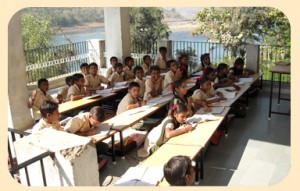
http://www.teach-india.com/index.htm
www.srianandamayima.org/new_projects
The Narmada (Devanagari: नर्मदा, Gujarati: નર્મદા) ,also called Rewa is a river in central India and the fifth largest river in the Indian subcontinent. It forms the traditional boundary between North India and South India and flows westwards over a length of 1,312 km (815.2 mi) before draining through the Gulf of Cambey (Khambat) into the Arabian Sea, 30 km (18.6 mi) west of Bharuch city of Gujarat. Read More > Here <
The Narmada Dam Project is a large hydraulic engineering project involving the construction of a series of large irrigation and hydroelectric multi purpose dams on the Narmada River in India. The project was first conceived of in the 1940s by the country’s first prime minister, Jawaharlal Nehru. The project only took form in 1979 as part of a development scheme to increase irrigation and produce hydroelectricity. Of the thirty large dams planned on river Narmada, Sardar Sarovar Dam (SSD) is the largest structure to be built. It has a proposed final height of 136.5 m (448 ft). The project will irrigate more than 18,000 km2 (6,900 sq mi), most of it in drought prone areas of Kutch and Saurashtra. Critics maintain that its negative environmental impacts outweigh its benefits. Read More: > HERE <
A COMMERICAL AIR TICKETING SERVICE WITH A SOCIAL MOTIVE BY OMKAR SPIRITUAL TOURS – Ever thought that four flight ticket can elevate somebody´s hopes? Ever thaught that every time you fly, somebody´s future prospects could also take wings? Now this can happen by simply booking your air tickets with Omkar Spiritual Tours, a vital and innovative tours and travel service concern.
ALL PROCEEDS FROM THIS COMMERICAL SERVICE WILL GO TOWARDS THE RUNNING OF THE OMKARESHWAR SCHOOL.
Omkar Spiritual Tours is a business venture run by entepreneurs who have begun this work out of a spirit of charity to fund a very active NGO (noncommercial Organization) — a free school for local village children in Omkareshwar, India. Omkar Tours is a commerical project specifically begun for supporting an important social project.
At Omkar Tours, you are our guests and our fellow workers for a noble project, and not mere customers. All our guests receive unparalleled attention and care. Come and experience the spiritual side of India, and at the same time contribute to a worthy cause!
Omkar Tours is not a cold business venture run by entrepreneur, but a vibrant group of dedicated devotees who have begun this work out of a spirit of charity to fund the ashram free school. All the proceeds go for the running of the Omkareshwar School for the local village children, and all the workers connected with this venture are devotees of Ma Anandamayi Ashram and are spiritual people in their own right.
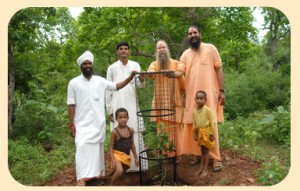
The Wonder of Omkareshwar – In Cooperation with Israelian Agriculture Students a System has found where 98 % of the thousend planted trees survived on this rocky and difficult soil on the island above the Narmada River. The Indian Forest Minister stunned and reported about the many tree planting projects where the trees only on paper exist, because only a few trees surviving in lack of water or difficult soil the first years.
THE SCHOOL ABOVE THE NARMADA RIVER – On the hill above the Ashram (The word ashram comes from “ah—without” and “shram—stress”. An ashram is a spiritual center, meant to be a place of quiet and peace and a place for spiritual discipline and meditation practice.) Swami Kedarnath and Dr. Swami Gurusharanan founded Mata Anandmayi Tripura Vidyapeeth, a thriving school for the local village children. The school is invaluable to the local community in offering free education to children from the poorest living conditions. Without it, the children would almost certainly have no chance for essential development in life.
The school offers a unique style of education: while all the traditional subjects are extensively covered, emphasis is also placed on Dharma (the Eternal Path of Righteousness), moral values and character development, service to society and religious studies.
400 children between the ages of 6-18 currently attend Mata Anandmayi Tripura Vidyapeeth. Demand for places is high and the school is eager to respond, although finding teachers in such a remote part of India is a constant struggle.
The school initiates projects to help their local community and the school, such as litter-picking of the island or removing rubbish from the Narmada River on which it sits. Anyone who’s been to India will recognise the cultural unawareness of litter and it’s impact on the environment. Mata Anandmayi Tripura Vidyapeeth’s shaping of young hearts and minds to appreciate the need to care for their local environment is truly commendable.
Hands-on work to help their community is known as Sewa and instils a sense of respect and responsibility for their local community. This shines through upon meeting the children and is deeply missing in modern societies.
Projects range from small to large in size and continue throughout the school year.
-
FOR AIR TICKET BOOKING; PLEASE CONTACT OMKAR SPIRITUAL TOURS:
-
24-A, Sangam Nagar, Tel: 0731-4208267, Mob.: 9926902690 (Shivam Thakker)
Medha Patkar – Water and Enviroment

www.rightlivelihood.org/narmada.html
www.citizen-news.org/Articles Medha Patkar
Medha Patkar (Marathi: मेधा पाटकर, born December 1, 1954) is an Indian social activist. She is known for her role in Narmada Bachao Andolan. Author Jacques Leslie devoted a third of his book, Deep Water: The Epic Struggle Over Dams, Displaced People, and the Environment (Farrar, Straus & Giroux, 2005), to a portrait of Patkar as she planned to drown herself in rising reservoir waters behind the Sardar Sarovar Dam, whose construction she fought for two decades. Read More: > HERE <
World Water Day is observed on March 22 since 1993 when the United Nations General Assembly declared March 22 as World Day for Water. This day was first formally proposed in Agenda 21 of the 1992 United Nations Conference on Environment and Development (UNCED) in Rio de Janeiro, Brazil. Observance began in 1993 and has grown significantly ever since. The UN and its member nations devote this day to implementing UN recommendations and promoting concrete activities within their countries regarding the world’s water resources. Each year, one of various UN agencies involved in water issues takes the lead in promoting and coordinating international activities for World Water Day. Since its inception in 2003, UN-Water has been responsible for selecting the theme, messages and lead UN agency for the World Day for Water.
In addition to the UN member states, a number of NGOs promoting clean water and sustainable aquatic habitats have used World Day for Water as a time to focus public attention on the critical water issues of our era. Read More: > HERE <
The construction of large dams on the River Narmada in central India and its impact on millions of people living in the river valley has become one of the most important social issues in contemporary India. Through this website, we the friends of the Narmada valley and its people hope to present the perspective of grassroots people’s organisations on the issue. Read an introduction to the issue.
The Friends of River Narmada is an international coalition of organisations and individuals (mostly of Indian descent). The coalition is a solidarity network for the Narmada Bachao Andolan (Save the Narmada Movement) and other similar grassroots struggles in India. More info about us.
www.worldwaterforum5.org 2nd World Water Forum in The Hague, Netherlands, in 2000. Speech by Medha Patkar against privatization of water. John Briscoe (WorldBank) held his speech just before Patkar.
www.unwater.org/worldwaterday International World Water Day is held annually on 22 March as a means of focusing attention on the importance of freshwater and advocating for the sustainable management of freshwater resources.
An international day to celebrate freshwater was recommended at the 1992 United Nations Conference on Environment and Development (UNCED). The United Nations General Assembly responded by designating 22 March 1993 as the first World Water Day.
Each year, World Water Day highlights a specific aspect of freshwater. On this page, we present a brief overview of the different themes that have been the focus of World Water Day celebrations.
Nature Conservancy – Biodiversity Projects

Conservation International (CI) is a nonprofit organization headquartered in the Washington, D.C. metropolitan area, that seeks to protect Earth’s biodiversity „hotspots,“ high-biodiversity wilderness areas as well as important marine regions around the globe. The group is also known for its partnerships with local non-governmental organizations and indigenous peoples. CI was founded in 1987 by Spencer Beebe and Peter Seligmann and now has a staff of more than 900 employees. Its work occurs in more than 45 countries, primarily in developing nations in Africa, Asia, Oceania, and the Central and South American rainforests. Building upon a strong foundation of science, partnership, and field demonstration, Conservation International empowers societies to responsibly and sustainably care for nature for the well-being of humanity. Read More: > HERE <
Hans Rosling (born July 27, 1948 in Uppsala, Sweden) is Professor of International Health at Karolinska Institute and Director of the Gapminder Foundation, which developed the Trendalyzer software system. From 1967 to 1974 he studied statistics and medicine at Uppsala University, and in 1972 he studied public health at St John’s Medical College, Bangalore. He became a licenced physician in 1976 and from 1979 to 1981 he served as District Medical Officer in Nacala in northern Mozambique. Rosling’s research has also focused on other links between economic development, agriculture, poverty and health in Africa, Asia and Latin America. He has been health adviser to WHO, UNICEF and several aid agencies. In 1993 he was one of the initiators of Médecins sans frontières in Sweden. Read More > Here <
Conservancy Yunnan The alpine ecosystems mountain areas that lie above the treeline – of northwestern Yunnan are some of the most biologically rich systems in the world. Home to such endangered species such as the snow leopard and blue sheep, this unique area provides important ecosystem services such as water storage, medicinal plants, and grazing for livestock. For example the rare snow lotus, which grows in the rocky upper slopes at elevations over 4,000 meters, is used by Tibetans to treat high blood pressure.
Unfortunately, these ecosystems are currently under siege by incompatible land uses and climate change. The Nature Conservancy has joined together with the Center for Biodiversity and Indigenous Knowledge (CBIK) and academic researchers to initiate a project focused on protecting these treasured and threatened ecosystems.
Goals • Gain a clear understanding of northwest Yunnan’s alpine ecosystem and identify immediate threats • Develop and implement climate adaptive conservation strategies based scientific, social, cultural, political, and economic factors • Maintain a healthy alpine ecosystem
What the Conservancy is Doing – During October 2003, the Conservancy and its partners traversed the mountain ranges of northwestern Yunnan collecting mapping data and investigating the ecological, political, and economic status of alpine areas across the project area. We interviewed local villagers, gathered information on ecological health, and set up initial photo monitoring sites to serve as the baseline for annual monitoring of these systems. During the course of 2004, we will work with partners and communities to continue research as well as begin to implement “no-regret” conservation strategies.
http://carlsafina.org , www.gapminder.org
http://www.ted.com The Gulf oil spill dwarfs comprehension, but we know this much: it’s bad. Carl Safina scrapes out the facts in this blood-boiling cross-examination, arguing that the consequences will stretch far beyond the Gulf — and many so-called solutions are making the situation worse.
Blue Ocean Institute – From Arctic Alaskan fishing villages to Zanzibar’s shores, the staff of Blue Ocean Institute studies and articulates how the ocean is changing and how everything humans do—both on land and at sea—affects the waters, wildlife, and people of our world. But gloomy environmental warnings and predictions don’t move people to make changes that can help our shared ocean. MacArthur Prize-winning scientist/author Dr. Carl Safina and Mercédès Lee created Blue Ocean Institute in 2003 as a unique voice of hope, guidance, and encouragement.
Blue Ocean Institute is the only conservation organization that uses science, art, and literature to inspire a closer bond with nature, especially the sea. We translate scientific information into language people can understand and use to make better choices on behalf of the sea. Whether you’re a fisherman, seafood lover, student, faith leader, parent, artist, or chef, our programs help you learn how and why you should protect our planet’s life-giving ocean.
Ocean Climate Change – This project is dedicated to turning the science of climate change effects on ocean life into stories that are accessible to policy, public, and scientific communities. We seek to identify those areas of research that are lacking attention, or are particularly complicated, and write articles in both academic and popular media formats about these underrepresented or important subjects.
“Climate change” is really “carbon change” and is not just about warming. We currently focus on how climate change alters ocean chemistry, and how that can affect every creature in the sea by forcing them to devote more energy to coping with excess carbon dioxide in the ocean. Since January, this initiative has already produced several articles, ranging from online journals to environmental faith-based magazines. Our published articles call for a wider appreciation and reporting of climate change effects on marine life. Please see our staff publications page to see articles on this issue.
Grameen Shakti Solar Renewable Power
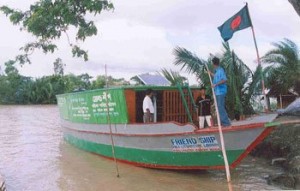
www.sourcewatch.org/Renewable_energy
www.rightlivelihood.org/grameen_shakti.html
www.gshakti.org Solar
Muhammad Yunus (Bangla: মুহাম্মদ ইউনুস, pronounced Muhammôd Iunus) (born 28 June 1940) is a Bangladeshi banker, economist and Nobel Peace Prize recipient. He previously was a professor of economics where he developed the concepts of microcredit and microfinance. These loans are given to entrepreneurs too poor to qualify for traditional bank loans. Yunus is also the founder of Grameen Bank. In 2006, Yunus and the bank were jointly awarded the Nobel Peace Prize, „for their efforts to create economic and social development from below.“Yunus himself has received several other national and international honors. He is the author of Banker to the Poor and a founding board member of Grameen America and Grameen Foundation. > HERE < The Grameen Bank is a microfinance organization and community development bank started in Bangladesh that makes small loans (known as microcredit) to the impoverished without requiring collateral. The system is based on the idea that the poor have skills that are under-utilized. The bank also accepts deposits, provides other services, and runs several development-oriented businesses including fabric, telephone and energy companies. The organization and its founder, Muhammad Yunus, were jointly awarded the Nobel Peace Prize in 2006. Read More: > HERE <
Grameen Shakti (GS) has developed one of the most successful market based program with a social objective for popularizing Solar Home Systems (SHSs) including other renewable energy technologies to millions of rural villagers.
Currently GS is one of the largest and fastest growing rural based renewable energy companies in the world. And Bangladesh, a country with one of the most successful renewable energy program in the world. As of December 2009, GS has installed more than 3,20,000 SHSs in rural areas with more than 12,000 SHSs installed per month. This success especially was the result of unique approach, blending market and social forces together to take world’s most up to date technology to the rural people.
„It is a fact that the future belongs to Renewable Energy Technologies. But unless this technology can reach the millions of rural people who suffer most from the energy crisis, it will not reach its full potential, and neither will the economic and social problems of the world be solved. — Dipal Barua
GS used its Grameen Bank’s experience to evolve a financial package based on installment payment which reduced costs and helped it to reach economy of scale. GS had to earn the good will of the rural people and especially provide excellent after sales services to ensure the success of its program. GS engineers are also called social engineers. GS engineers train women technicians and provide them with employment, they administer a scholarship program for school children, they collect damaged batteries to ensure that these do not hurt the environment. GS engineers pay monthly visits to households during installment payment and ready to offer their services for a small fee, afterwards, if a client signs an annual maintenance agreement with GS.
„It is a fact that the future belongs to Renewable Energy Technologies. But unless this technology can reach the millions of rural people who suffer most from the energy crisis, it will not reach its full potential, and neither will the economic and social problems of the world be solved. — Dipal Barua
GS solar PV program really took off the ground when rural clients realized SHSs are more cost effective than other conventional sources of energy such as kerosene and provide more utilities.
GS started its biogas program in 2005 and Improved Cook Stoves Program in 2006. GS’s biogas program is the first market based program in Bangladesh. Both programs have become popular with the rural people and show an accelerating trend.
Rural electrification through solar PV technology is becoming more popular, day by day in Bangladesh. Solar Home Systems (SHSs) are highly decentralized and particularly suitable for remote, inaccessible areas. GS’s solar program mainly targets those areas, which have no access to conventional electricity and little chance of getting connected to the grid within 5 to 10 years. It is one of its most successful programs. Currently, GS is one of the largest and fastest growing rural based renewable energy companies in the world. GS is also promoting Small Solar Home System to reach low income rural households.
SHSs can be used to light up homes, shops, fishing boats etc. It can also be used to charge cellular phones, run televisions, radios and cassette players. SHSs have become increasingly popular among users because they present an attractive alternative to conventional electricity such as no monthly bills, no fuel cost, very little repair, maintenance costs, easy to install any where etc.
GS installed SHSs have made a positive impact on the rural people. GS has introduced micro-utility model in order to reach the poorer people who cannot afford a SHS individually. Another successful GS venture is Polli Phone which allows people is off grid areas the facilities of telecommunication through SHS powered mobile phones.
Siddha system of Indian medicine

http://agasthiaherbal.tripod.com
Bio Piracy – Commercialization_of_trad. medicines
http://healingfromtheroots.blogspot.com
The Siddha medicine is a form of south Indian Tamil traditional medicine and part of the trio Indian medicines – ayurveda, siddha and unani.This is nearly 10,000 years old medical system followed by the Tamil people, both in India and abroad. This system of medicine was popular in ancient India,due to the antiquity of this medical system,the siddha system of medicine is believed to be one of the oldest medical system. The system is believed to be developed by the 18 siddhas in the south called siddhar. They are the ancient supernatural spiritual saints of India and the Siddha system is believed to be handed over to the Siddhar by the Hindu God – Lord Shiva and Goddess Parvathi. So are the siddhars, the followers of Lord Shiva (Shaivaites). Siddhar’s total nos are eighteen, with agathiyar being the first Siddhar. Read More: > HERE <
Siddha system of medicine is one of the oldest medical systems of India existed separately in early times. The system has flourished well in India for many centuries. Although this system has declined in later years, in the wake of changing mode of life and modern medicine, it continues to sustain its influence on the masses because of its incomparable intrinsic merits. Siddha medicine can combat all types of diseases, especially the chronic diseases, which baffles and eludes even the modern sophisticated medicine.
There are two ancient systems of medicine in India, the Siddha which flourished in the south and the Ayurveda prevalent in north. Siddha system is called ‘saiva sampradayam’ (tradition of Lord Shiva) and Ayurveda is called Brahma or ‘Arsha sampradayam’ (the tradition of rishis). The inference to be drawn from these traditions is that, there is no exact point of time to which the beginning of these systems could be traced. They are eternal, without a beginning or end: they began with man and may end with him. The term ‘Siddha’ means ‘everlasting’, ‘Conquering death’, ‘holy immortals’, etc. This system is originated by 18 Siddhars headed by Siddha ‘AGASTHYA’. Siddhars were a Class of popular writers in Tamil in all branches of knowledge and many of their works were written in what is called High Tamil. They were men of high culture, intellectual and spiritual faculties combined with supernatural powers and intuitive intelligence acquired by yogic powers. The prevention and the cure of illness is the basic aims of all systems of medicine.
The Siddha system has, in addition, a transcendental motivation, a concern for what might be called the ‘IMMORTALITY OF THE BODY’. The ‘Siddhars’ were those who had renounced the world after experiencing its instability and uncertainties. They practiced yoga extensively and wrought great miracles, imbued with Devine power. They knew the past, the present and the future, rejuvenated their body, lived for many years, ultimately attained the state of ‘perpetual consciousness’ or ‘Samadhi’ and enjoyed eternal bliss. Big Hindu Temples sprang up over their Samadhi and centers of devout worship even today. They form the most important temples in south India.
Fundamental principles of Siddha – According to siddhars ‘Nature is man and man is nature’, therefore both are essentially one. The universe consists of two essential entities, matter and energy which the Siddhars call ‘Siva’ and ‘Shakthi’. The two co-exist and are inseparable.
The universe consists of five elements and these elements should not be confused with the elements of modern chemistry. They are primordial elements. They are Munn (solid), Neer (fluid), Thee (radiance), Vayu (gas), and Akasam (ether). All created and evolved matter in the world, be it animal, vegetable, or mineral, falls under these categories. The human anatomy and physiology, the causative factor of disease, the materials for the treatment and cure of diseases, the food for the sustenance of the body, all fall within the five elemental categories. This is the working hypothesis.
The human being is made up of the five elements. The various tissues of the body are the combinations of these elements. In one tissue one element may be more predominant than the others. The physiological function in the body is mediated by three substances- Vatham, Pitham, and Kapham. In each cell in the body these three co-exist and function harmoniously. Vatham is formed by the basic elements Akasam and vayu. Pitham is formed by Thee and Kaph is formed by Munn and Neer. If these three functions normally, health is maintained. The body consists of seven ‘dhatus’: Rasa (lymph), Kurudi (blood), Tasai (muscle), Kozhuppu (fat), Elumbu (bone), Majja (marrow) and Sukkilam and Artavam (male and female hormones). In these seven tissues one or other of the three ‘doshas’ predominate. In the tissue blood, Pitham predominates, in bone Vatham and in other tissues Kapham. The doshas should not be pictured as separate entities staying in the body in different places. Though they are treated separately, it is to be understood that they combine in their action to make life go on; they may be compared to three pillars which supports a structure. They conjointly permeate every structure in the body; so much so there is not a single point in the body where all the three doshas are not present. The maintenance of equilibrium of the three doshas is health; the disturbance of the equilibrium is disease. The concept is similar to the theories of cellular mechanism, biochemical changes, enzymes and hormones, of modern medicine- Both Siddha and Ayurveda are based on humoral pathological doctrine- the tridosha theory- the three supports of human body system.
Diagnosis and basis of treatment – The words ‘noai nadal, noai mudal nadal’ in the ancient texts denotes the approach to disease and determination of the etiology of the disease. Siddha concept for diagnosis is to investigate the cause of the disease, the signs and symptoms, complications if any, and pathological tissue changes. The Siddhars look at body and disease together to arrive at a conclusion regarding the condition or diagnosis of the case. This condition is an essential pre-requisite for treatment. In addition, eight important factors are to be ruled out. They are pulse, touch, tongue, colour, speech, eyes, faceus and urine. The five elements of the body and their life factors: the five elements of the body (pancha bhootas) and Vatham, Pitham, and Kapham (tridoshas) are widely described by Siddhars who classified the diseases into 4448 varieties. The etiology, signs and symptoms and treatment were explained for all the varieties by Siddhars. Medicines should be prepared according to individual needs separately.
The three ‘humors’ Vatha, Pitha and Kapha represents air, fire and water of the five elements (pancha bhootas), which form the connecting link between microcosm or man and macrocosm or the earth. These three humors maintain the human body through their combined functioning. The normal order of tridosha in a healthy person is 1: ½: ¼ or 4:2:1 respectively. If this equilibrium is disturbed disease sets in. Medicine are prescribed to set right the imbalance in the life factors either by addition, reduction or neutralization, since all matters (herbs, minerals and metals) contain the five elements and hence three factors. The presence of a particular factor in a substance is found by the taste of the latter. The five elements in different combinations form six tastes. Innumerable varieties of herbs are mentioned in Siddha literature. Many of these were described in a manner very difficult to understand. There are 64 types of medicine in Siddha pharmacopoeia, 32 for internal administration and 32 for external applications, besides 11 metals, 64 mercurial and non-mercurial), 120 uparasam (salts and other minerals). Diet and Anupanam (vehicle for administration) plays a very important role in Siddha treatment. A single herb like ’solanum trilobatum‘ is used in 20 different diseases with different Anupanams.
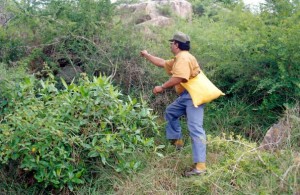
Unique Siddha medicinal preparations – For a medicine to be effective, the inorganic substances have to be brought to their atomic form. Siddhars developed the knowledge of bringing inorganic substances into atomic and ionic form which is easily absorbed by the system, when ground with herbal juices and put on the fire.
The specialized Siddha preparations are ‘parpam’, ‘chendooram’, ‘chunnam’, ‘mezhagu’. These are metallic and mineral preparations by transmutation processes of converting the metal to ashes and waxy constituency which exerts only therapeutic properties and devoid of any metallic traces. These are also the byproducts noticed during Siddhars Alchemical practices.
Muppu: Muppu has a distinct place in Siddha medicine. It is the combination of three rare salts which enhances the efficacy of any Siddha medicine. The preparation and ingredients are a closely guarded secret. It is also believed that ‘muppu’ also engender yogic concentration, a part of Siddha tradition.
Kaya kalpa: This is similar to ‘Rasayana chikitsa’ of Ayurveda and ‘gerontology’ of modern medicine. The word ‘kalpa’ means ‘able’, ‘competent’. When it is connected with ‘kaya’ or body, the term means competency or ability of the body. While in Ayurveda, rasayana is different from ‘vajeekarana’, kaya kalpa does not treat vajeekarana or the science of aphrodisiacs separately. When kayakalpa treatment is undertaken, the vigor of body and mind are restored and so there is no need for separate attention to vajeekarana. Siddhars were more concerned about the ultimate goal of living and less with worldly pursuit of sex. How ever, kayakalpa is very much capable of achieving the ends of both rasayana and vajeekarana.
Present status and scope: There are 6 Siddha medical colleges in Tamil nadu and one in Kerala catering to the needs of those who are interested in leaning siddha medicine course for 5 and half years and post-graduate specialization courses for two years.
Due to the popularity of ‘Siddha’ in India and abroad, the government of India has decided that Allopathic and Indian system of medicine should together contribute towards the development of the National Health Services. In addition, Indian system of medicine has also been recognized for the purpose of reimbursement of medical treatment under the central services.
The central council is executing its research programme in Siddha through Central research institute, regional research institute, mobile clinical research units, medico botanical survey unit etc. For the research in Siddha system, many research units were started at New Delhi, Bengalooru, Chennai, Pondycherry, Palayamkottai and Trivandrum.
“Food is medicine and medicine is food” and “Prevention is better than cure” were the slug lines of Siddhars and their followers. In the past people had the first hand information of the health and toxic effects of various species of flora and they provided the raw materials to the medical man for compilation. Thus Siddha system is a science perfected into an art, coupled with primitive intuitions into nature’s resources and secrets.
A close look at the eating habits of animals and birds reveals they eat food raw and ripe consisting of all the six tastes where as man eats only food stuff of four tastes, leaving bitter and astringent, which are pre-requisites for healthy circulation f blood. Bitterness fights against bacterial infection and astringency maintains the right blood quality and its constituents. Small quantities of agathi grandiflora, bitter gourd, seeds of solanum xanthocarpum, flowers of neem eaten now and then in small quantities, ward of many microbiological and bacterial infections.
It was a common knowledge for many Indian to possess the rare knowledge of various medicinal properties of ingredients in our culinary preparations and thus many an Indian woman trained in the traditional oriental ways of food preparation is an excellent and masterly physician without any master degree…
As a sampler, when excessive smoking causes dizziness, stomach disorders and makes the male suffer from nicotine poison, immediately the lady knows the sure cure for this disorder and gives him agathi grandiflora leaves, deliciously cooked at regular intervals and thus cures him of his malady, similarly she knows the properties of medicinal food recipes out of edible greens, leaves, barks, berries and other vegetables and the value of pepper, mustard, ginger and a host of other household provisions, rarely men of the past generations were perforce compelled to visit the medical experts and specialists who were scarce and few.
The leafy green mentioned above and several other bitter lasting foods and dishes as in margosa leaves and other plants and medicinal herbs, kill or exterminate the nematodes like thread worm, hookworm and tape worms and similar germs infesting the bowels and alimentary canal.
Religion is an indispensable stand in the web of Hindu Indian life that permeates through the daily life and character of Indians. The wise men of old India have deftly fused in their life certain ablutions, ceremonial rights and codes of conducts for normal healthy life. The Hindu Icons or the Pantheons of various Gods and particular modes of worship with leaves, flowers, milk, butter, honey, ghee, betel and nuts are symbolic and of great significance just as an abacus is used to induce children to learn arithmetic; these observations have been designed to promote for living a healthy life of body, mind and spirit. The practices may seem succinct or stupid to the modern civilization, but they were quite significant and sacred in the past.
The ancient wisdom of our ancestors should not be ridiculed because of our ignorance or non realization of their intrinsic worth. Let me present few examples of these rites and rituals and anyone with faithful, sincere interpretations of facts will come to the conclusion as how the medicine, art, culture, rituals and the way to healthy living with longevity were interwoven during prehistoric period.
While worshipping Lord Shiva, during the chanting and pooja, beal leaves (aegle marmelos) are offered to the Deity and after worship, some of these leaves are eaten by the devotees as ‘Prasad’ (blessings from God).this intake of beal leaves when followed regularly ensures good health by proper digestion and assimilation of food. It also removes the toxins in the body and is a blood purifier.
While worshipping mother Durga, the Goddess is being invoked with neem leaves and later consumed by the devotees. This is manna from heaven when consumed regularly in small quantities with its essence, as it proves wonderful disinfectant and germicide. Regular intake of this herb in any kind will be a sure elixir of life.
The foremost Hindu Deity Lord Ganesha, first to be propiated before commencing any important human project as per the belief. The Lord is worshipped with a particular type of grass – ‘Doorva’ (cynodon dactylon), which has been proven scientifically to possess the power of generating electricity in minute degree. When handling it augment one’s personal magnetism. It is of high medicinal value when administered orally. Another instance may seem superstitious but not without truth. Before initiating any auspicious rites, it is customary to make a crude image of Lord Ganesha with a fresh paste of either cow dung or turmeric paste and stick a small tuft of Doorva grass leaves to the person of the Deity. This image is abandoned and left to wither after performing pooja. Normally wet paste of either cow dung or turmeric when left exposed to atmosphere will be infested with bacteria and this does not happen with the sanctimonious Lord Ganesh’s image with the bunch of Doorva grass. It may baffle one’s imagination and one may not believe, but seeing believes!!!
Selection of purified herbs for compound Siddha preparations – Mango leaves are used in the worship of the Goddess of rivers- Ganga devi. Festoons of mango leave adorn temples and houses during festivals. A tuft of mango leaves dipped in the sacred water after worship Ganga is sprinkled over all the places of the premises and on the devotees. This serves as purificatory process. A decoction of mango leaves taken at regular intervals will cure many bodily illnesses.
The people of ‘Vishnu cult’ perform pooja of the Lord with ‘Tulsi leaves’ (ocimum sanctum). After the pooja 3-5 leaves are consumed as ‘Prasad’… these leaves consumed at regular intervals will build strong muscles and bones. It is also a wonderful prophylactic drug for many ailments.
Likewise ‘Lord Brahma’, the Creator is worshipped with country fig leaves and fruits. The intake of these leaves and fruits will restore the correct blood constituents due to its astringent properties. These few narrations give a glimpse into the astounding possibilities of simple herbal preparations with no intricate knowledge of orthodox Siddha compounds with elaborative preparation processes. With a primary knowledge of hundreds of species in vegetable kingdom and the knowledge of physical body, its physiology and anatomy and simple rules of health and hygiene, any layman can lead a healthy life free from diseases.
Similarly periodic oil-bath promotes real rejuvenation of the physical body, though the modern medical conception put it that the diet we take orally contain oily matter which could suffice for a healthy body. Folds and wrinkles disappear in due course, when taken regular oil bath, giving the person youth, glow and luster. There are many illustrations of Siddhars stating by proper physical exercise and perfect breathing, food habits, evacuation of bowels, many undesirable conditions get eliminated. Siddhars have also propounded many prescriptions for rejuvenating the body and this bulk is called ‘Kayakalpa’, literally meaning a body like stone. The most intriguing, perplexing and unique phenomenon of Siddha system of medicine is the ‘Kayakalpa group of herbs’ which is not found in any other systems of medicine in the world. These ensure physiotherapy, psychotherapy, preventive and curative aspects of diseases and pave the way for longevity. There are 108 kayakalpa herbs; many among them in daily use are onion, garlic, ginger, lemon, jequirity and turmeric etc.
On close scrutiny one will struck with much wonder as in how those days where there was not even a microscope, the ancient Siddhars were capable of describing the use of such things rich in vitamins, minerals, proteins, hormones, electrolytes and other nutrients grouped them as disease preventives for promoting longevity.
To conclude these scriptures and sciences embody all that was required for human advancements in the world and a study of these ancient literatures will be really productive of lasting benefits. We may confess that we are still ignorant of many things connected with the ancient thoughts and beliefs and it is our ignorance that belittles their greatness.
The revival of ancient systems, be they in medicine or moral code, requires a faithful interpretation of the views of the originators of these sciences and such a movement will be useful and indeed found necessary since modern discoveries still are incomplete and look forward to the ancient works for the ‘MISSING LINKS’.
The Siddha system of medicine deserves careful and faithful examination since it has in itself many principles which may go a long way to supply the defects and deficiencies of modern conceptions and that may save Indian society and generally the world from many a besetting peril…..
Exciting possibilities ahead: In conclusion, it must be said that Siddha medicine offers exciting avenues for investigations in the light of modern science and technology. Such investigations can lead to significant breakthroughs not just in herbal pharmaceuticals, but in conceptual and practical knowledge as well, with far-reaching benefits for the existing system of healthcare as a whole. But such investigative studies must necessarily be multidisciplinary, with full involvement of scholars in ancient Tamil scriptures, veteran Siddha Vaidyas, and tribal folks with knowledge of field work, historians and several other members of Siddha medical community at the local level. Exploration of the goldmine of Siddha knowledge and wisdom is certainly worth substantial investments of human and financial resources.
– Authored by Siddha vaidya P.S.Narasimha swamy,
Director- Agasthya Siddha literature research centre,
#1495, Dr. Ambedkar Road,
Krishna murthy puram, Mysore-5700 04 Cell: 09845167119
e-mail: swamy_siddha@yahoo.com , agasthyaswamy@gmail.com
Meet Narasimha Swamy (Agasthya Siddha), friends, fans at fb <
Esma Redžepova and Cultural Biodiversity
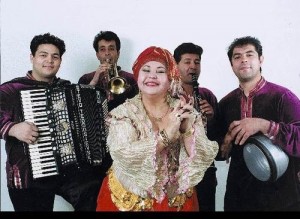
www.sinti-roma.at www.verein-roma.at
Esma Redžepova (Macedonian: Есма Реџепова) is a Romani Macedonian vocalist, songwriter, and humanitarian born in Skopje, SFR Yugoslavia (today Republic of Macedonia). During her life she has performed in more than 8000 concerts in 30 countries, with her late husband Stevo Teodosievski she has fostered forty-seven children, and she has received numerous accolades for her humanitarian work. By her own account she has created more than 500 works of art. These include 108 singles, 20 albums, and 6 movies. Read more: > HERE <
Cultural diversity is the variety of human societies or cultures in a specific region, or in the world as a whole. (The term is also sometimes used to refer to multiculturalism within an organization. This article does not currently cover that alternative meaning.) There is a general consensus among mainstream anthropologists that humans first emerged in Africa about two million years ago.Since then they have spread throughout the world, successfully adapting to widely differing conditions and to periodic cataclysmic changes in local and global climate. The many separate societies that emerged around the globe differed markedly from each other, and many of these differences persist to this day . Read More: > HERE <
Esma Redzepova travelled all over the world: New York, London, Sydney, Paris (appearing for the first time at Olympia in 1962), Mexico, India (where she was acclaimed as the Queen of Romany Songs at the first world festival of Romany music in 1976). With obvious pride she claims to have performed at more than 22,000 concerts, with a repertoire of over 800 songs. There is no way of checking such figures, but whatever their veracity they are on a par with the legend she has created. At her home in Skopje, capital of the republic of Macedonia, there is no doubt about her standing as a star in the Roma community.
The Gyspy Queen Esma Redzepova and the Nederlands Blazers Ensemble during the 1999 New Year’s Concert in the Concertgebouw, Amsterdam. Also playing, special guest François Castiello (Bratsch).
In addition to her work as a singer, Redzepova has become an ambassador for Roma culture. In the course of her travels in and around the Balkans, she has adopted 47 children who were living on the street and introduced them to the joys of music. The musicians who now accompany her at concert performances and on recordings belong to this extended family. For several years she has been actively involved in the management of Rom-Esma, a non-governmental organisation she set up to uphold the rights of Roma women and more largely the community worldwide. When asked about disparaging remarks about travellers by the French president, Nicolas Sarkozy, she cited the example set by Macedonia.
„It is the only country where the Roma are recognised,“ Redzepova says. They enjoy access to education, culture (with two privately owned Roma television channels) and civic life (as the leader of a local council or MP). She is proud to have been born in Macedonia, because in other countries „the Roma are not respected and must endure humiliation and persecution“, she says. When she performed the following evening she made a point of reasserting the cosmopolitan values and traditions of pacifism and freedom upheld by Travellers.
Sufism International & the Hope Project
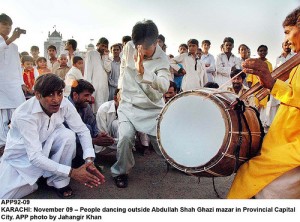
www.unesco.org/Intangible Heritage
Sufism or taṣawwuf (Arabic: تصوّف) is, according to its adherents, the inner, mystical dimension of Islam. A practitioner of this tradition is generally known as a ṣūfÄ� (صُوفِيّ). Another name for a Sufi is Dervish. Classical Sufi scholars have defined Sufism as „a science whose objective is the reparation of the heart and turning it away from all else but God.“Alternatively, in the words of the Darqawi Sufi teacher Ahmad ibn Ajiba, „a science through which one can know how to travel into the presence of the Divine, purify one’s inner self from filth, and beautify it with a variety of praiseworthy traits.“ Classical Sufis were characterised by their attachment to dhikr (a practice of repeating the names of God) and asceticism. Sufism gained adherents among a number of Muslims as a reaction against the worldliness of the early Umayyad Caliphate (661-750 CE[6]). The Sufi movement has spanned several continents and cultures over a millennium, at first expressed through Arabic, then through Persian, Turkish and a dozen other languages. „Orders“ (ṭuruq), which are either SunnÄ� or ShÄ�‘Ä� in doctrine, trace many of their original precepts from the Islamic Prophet Muhammad through his cousin ‘AlÄ�, with the notable exception of the Naqshbandi who trace their origins through the first Caliph, Abu Bakr. Other exclusive schools of Sufism describe themselves as distinctly Sufi. Read more: >here<
Naqshbandi (an-Naqshbandiyyah, Nakşibendi, Naksbendi, Naksbandi) is one of the major tasawwuf spiritual orders (tariqa) of Sufi Islam. It is considered to be a „sober“ order. The Naqshbandi order is nearly 1,500 years old, and is active today. It is the only Sufi order that claims to trace its direct spiritual lineage (silsilah) to Muhammad through Abu Bakr, the First Caliph and Muhammad’s companion. This lineage also indirectly connects to Ali Muhammad’s cousin, son-in-law and the Fourth Caliph, via Jafar as-Sadiq. In contrast, most other Sufi orders (turuq) trace their lineage through Ali. It is considered that the transmission of spiritual lineage or silsilah, is directly from one Sheikh to another, at or after the time of death or burial. It is not tied to a country, family or political appointment, but is a direct heart to heart transmission. It is also considered that the appointed Sheikh will be in some communication with past Sheikhs. At any one time, there will of course be many other Sheikhs, who will all naturally owe their spiritual allegiance (Beyat) to the current master of the silsilah. Read more: >here<
Sufism, the West, and Modernity – In the twentieth century Sufism began to spread in the West. An uneven and spotty but still useful introductory on-line article is A History of Western Sufism (fixed January, 2005) by Prof. Andrew Rawlinson of the University of Lancaster. The following articles by Kinney and Bayman illustrate some general trends and issues:
The Sufi Conundrum, written by Jay Kinney, the publisher and editor-in-chief of the magazine Gnosis, discusses a number of issues confronting Americans as they investigate the nature and practice of Sufism today.
Sufism and Modernity (link fixed, Dec. 10, 2004) is a chapter from the on-line book Science, Knowledge, and Sufism, (link fixed 20 August, 2005) by Henry Bayman (author of The Station of No Station: Open Secrets of the Sufis ), a disciple of the Turkish Shaykh Ahmet Kayhan (d. 1998). This particular chapter consists largely of a Sufi analysis of modernity, solidly based upon the writings of other scholars who have written about modernity, scholars such as Marshall Berman, Charles Taylor, and Alain Touraine. Sufism in the West falls into four general categories: http://www.uga.edu/islam/sufismwest.html
Surrounding the shrine of Inayat Khan and the other holy places in the Nizamuddin district of New Delhi is a neighborhood where many children live in poverty and isolation. The Hope Project is the outgrowth of a milk program originally begun on Pir Vilayat’s initiative here. These kids go to school there and prepared a program for this event. The Hope Project is supported primarily by donors from all the Orders of Inayat Khan’s lineage. For information contact Quan Yin (quanyinlyn@gmail.com). / Sufism – a mystical strand of Islam – originated in the Islamic cultures of Asia and Africa, but it also has a growing following in the U.S. Its growth is attributed in large part to the teachings of Bawa Muhaiyaddeen, a Sufi mystic. To learn more about the man and his teachings, Imran Siddiqui of VOA’s Urdu Service visited his mazar – or mausoleum – in the eastern U.S. state of Pennsylvania, which has become a gathering place for many followers of Bawa Muhaiyaddeen.
The Hope Project was founded in 1980 by the Sufi teacher, Pir Vilayat Inayat Khan. Moved by the extreme poverty of the people living near the mausoleum of his father Hazrat Inayat Khan, he envisioned a program, which would enable the poor to help themselves.
Located in Basti Hazrat Nizamuddin, the Hope Project currently runs a community health centre, a creche, a non-formal school, vocational training courses, a thrift and credit program, and a women’s micro-enterprise unit.
The project has 70 staff members, many of whom come from the community. It is financed largely by private donations from the international Sufi community and other donor agencies.
Guided by the spiritual ideals of Hzt. Inayat Khan, the Hope Project is driven by the spirit of service to humanity and respect for all religions. It strives to provide people, especially the poor and vulnerable, with opportunities and resources, so that they can realize their hidden potential and determine their own future.
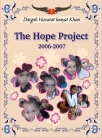
www.hopeprojectindia.org/reports.htm
- Articles o Sufism < , Articles on Pakistan & Flood Relief<
- Sufism – UNESCO Documents and Publications <
- http://aulia-e-hind.com , http://www.aulia-e-pakistan.com
- www.sufimovement.us , www.kashmirsufism.org
- www.haqq.com.au , www.sufismus.ch
- www.mevlana800.info , www.hope-project.de
- www.australiansuficentre.org , www.osmanische-herberge.de
- Meet International Year of Biodiversity 2010, friends, fans at fb <
- Meet NCCT (National Campaign For Combating Terrorism)at fb <
- Meet COP16 to the UN Framework Convention on Climate Change at fb <
- Meet Council for a Parliament of the World’s Religions (CPWR)at fb <
SOS Water Poisoning, Health Care & Wells
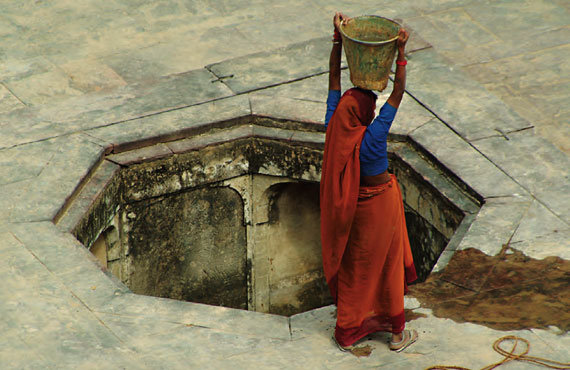
Arsenic_contamination_of_groundwater
The Bhopal disaster or Bhopal Gas Tragedy is the world’s worst industrial catastrophe. It occurred on the night of December 2-3, 1984 at the Union Carbide India Limited (UCIL) pesticide plant in Bhopal, Madhya Pradesh, India. UCIL was the Indian subsidiary of Union Carbide Corporation (UCC). Indian Government controlled banks and the Indian public held a 49.1 percent ownership share. In 1994, the Supreme Court of India allowed UCC to sell its 50.9 percent share. The Bhopal plant was sold to McLeod Russel (India) Ltd. UCC is now a subsidiary of Dow Chemical Company. A leak of methyl isocyanate (MIC) gas and other chemicals from the plant resulted in the exposure of several thousands of people. A leak of methyl isocyanate (MIC) gas and other chemicals from the plant resulted in the exposure of several thousands of people. Estimates vary on the death toll. The official immediate death toll was 2,259 and the government of Madhya Pradesh has confirmed a total of 3,787 deaths related to the gas release. Other government agencies estimate 15,000 deaths. Others estimate that 8,000 died within the first weeks and that another 8,000 have since died from gas-related diseases.
“ C L E A N U P “ : Chemicals (~390 tons) abandoned at the plant continue to leak and pollute the groundwater. Whether the chemicals pose a health hazard is disputed. Read More: > HERE <
The Sambhavna Trust is a charitable trust run by a group of eminent doctors, scientists, writers and social workers who have been involved with various aspects of the Union Carbide disaster ever since its occurrence in December 1984. The Chairperson of Sambhavna, Dr. PM Bhargava, was awarded the „Padma Bhushan“ by the President of India in 1986 and the „Legion d’Honneur“ in 1998 by the French government for his scientific and social contributions. Dr. H H Trivedi, former Professor at the Gandhi Medical College and Satinath Sarangi are the two Bhopal based trustees of Sambhavna.
Many are unaware that the disaster in Bhopal continues to this day. An estimated 120,000-150,000 survivors of the disaster are still chronically ill. Over 23,000 have died of exposure-related illnesses and more are dying still. Tens of thousands of children born after the disaster suffer from growth problems and far too many teenaged women suffer from menstrual disorders. TB is several times more prevalent in the gas-affected population and cancers are on the rise.
The Bhopal Medical Appeal was launched in 1994, when a man from Bhopal came to Britain to tell whoever would listen about the calamitous condition of the still suffering victims of the Union Carbide gas disaster. Those who met him learned that after ten years, the survivors had received no meaningful medical help. (Unless one is prepared to accept that aspirin is a cure-all for the dreadful illnesses visited on them.)
The survivors realised that they must help themselves, because nobody else would. They wanted to open their own free clinic for gas victims. They were joined in the UK by a few individuals who put the mechanics of the Appeal together. They were in turn joined in this effort by other like minded people. Our newsletter is called 777. The name arose from an attempt to capture the spirit of the Appeal. Someone suggested, ’saat, saat, saat‘, which in Hindi means ‚together, together, together‘, but with a slight twist of the tongue could also mean ’seven, seven, seven.‘ ‚We‘ means all of us, all together.
BhopalMedicalAppeal /Arsen Water Myanmar/Arsen Water Pakistan
Thirty years ago, Bangladeshi villages began pumping arsenic-laced water in a development project gone awry. Why will it take another 30 years to halt the biggest mass poisoning in history?
The story beggars belief. In the 1970s, international agencies headed by the United Nations Children’s Fund (UNICEF) began pumping millions of dollars of aid money into Bangladesh for tubewells to provide “clean” drinking water. According to the World Health Organization, the direct result has been the biggest outbreak of mass poisoning in history. Up to half the country’s tubewells, now estimated to number 10 million, are poisoned. Tens, perhaps hundreds of thousands will die.
Even now as the scale of the calamity emerges, nobody is admitting culpability. Not UNICEF, which initiated the tubewells programme and paid for the first 900,000 wells, nor the WORLD BANK, a fellow sponsor. Not the Bangladeshi government, or the foreign engineers and public health scientists who did not think to test the water for so long.
Arsenic contamination of groundwater is (not always natural!) a natural occurring high concentration of arsenic in deeper levels of groundwater, which became a high-profile problem in recent years due to the use of deep tubewells for water supply in the Ganges Delta, causing serious arsenic poisoning to large numbers of people. A 2007 study found that over 137 million people in more than 70 countries are probably affected by arsenic poisoning of drinking water.
Arsenic contamination of ground water is found in many countries throughout the world, including the USA. Approximately 20 incidents of groundwater arsenic contamination have been reported from all over the world. Of these, four major incidents were in Asia, including locations in Thailand, Taiwan, and Mainland China. South American countries like Argentina and Chile have also been affected. There are also many locations in the United States where the groundwater contains arsenic concentrations in excess of the Environmental Protection Agency standard of 10 parts per billion adopted in 2001.
Arsenic Catastrophe in Bangladesh: Project To Support the Poorest Rural Population in Bangladesh, Enhance Environmental Consciousness, Regain Traditional Wisdom. and Cultural Heritage . The people will invent more methods and survival strategies, if we really want to survive and refuse vested business interests of many western countries offering inadequate and expensive technologies. We need your help to make this extraordinary project a success. Every step of the project will be accompanied with on-line reports on this page, which will enhance your active participation.
Our goal is to help these people help themselves escape death. By the people, for the people, using simple, affordable methods….You can help by donating any amount: One arsenic free well costs less than 100 EUR – just donate 1 EUR. Solidarity for the poor- Also for Recent Cyclone Disastor: www.sos-arsenic.net
![]()
- www.unwater.org
- The immediate alternatives from http://www.sos-arsenic.net are:
- Deep tube wells in Southern Bangladesh, with special reference to saline water intrusion and improved drilling methods on a contaminated aquifer. „Arsenic free water trap“ at shallow depths. Rain water harvesting. Dug wells, only when „shallow water trap“ is not available. Low cost community based water purification units.
- New and immediate agricultural policy – „Flood Water Irrigation“.
- Regain traditional wisdom.
- http://en.wikipedia.org/wiki/Arsenic_poisoning
http://en.wikipedia.org/wiki/Arsenic_contamination_of_groundwater - http://www.unesco.org/courier/2001_01/uk/planet.htm <
- Meet Transparency International, friends, fans at fb <
- Meet the Bhopal Medical Appeal, friends, at fb <
- Meet Arsenic & Health Research in Bangladesh at fb <
Erwin Kräutler – Right Livelihood Award

www.rightlivelihood.org/krautler.html
www.cimi.org.br (CIMI)
http://plattformbelomonte.blogspot.com
www.survivalinternational.org/news
The Right Livelihood Award, established in 1980 by Jakob von Uexkull, is an award that is presented annually, in early December, to honour those „working on practical and exemplary solutions to the most urgent challenges facing the world today“. An international jury, invited by the five regular Right Livelihood Award board members, decides the awards in such fields as environmental protection, human rights, sustainable development, health, education, and peace. Read More: > HERE <
Erwin Kräutler CPPS, auch Dom Erwin, (* 12. Juli 1939 in Koblach, Vorarlberg) ist römisch-katholischer Bischof und Prälat von Xingu, der flächenmäßig größten Diözese Brasiliens. 2010 wurde sein Einsatz für die Rechte der Indios und die Erhaltung des Amazonas-Urwalds mit dem alternativen Nobelpreis ausgezeichnet. Read More: > HERE <
Erwin Kräutler, a Catholic Bishop motivated by liberation theology, is one of Brazil’s most important defenders of and advocates for the rights of indigenous peoples. Already in the 1980s, he helped secure the inclusion of indigenous peoples‘ rights into the Brazilian constitution. He also plays an important role in opposing one of South America’s largest and most controversial energy projects: the Belo Monte dam.
Kräutler was born in Austria on July 12th, 1939, became a priest in 1965 and shortly after went to Brazil as a missionary. In 1978, he became a Brazilian citizen (though also keeping his Austrian citizenship). He worked among the people of the Xingu-Valley, who include indigenous peoples of different ethnic groups. In 1980, Kräutler was appointed Bishop of Xingu, the largest diocese in Brazil. From 1983-1991, and since 2006 he is the President of the Indigenous Missionary Council (CIMI) of the Catholic Church in Brazil.
Kräutler is motivated in his work by the teachings of liberation theology. He teaches that a Christian has to take the side of the powerless and to oppose their exploiters.
Working for indigenous peoples‘ rights – For five centuries, the population of Brazil’s indigenous peoples has constantly decreased – and the downward trend still continues. Today the causes are well-known and documented, including direct (yet rarely investigated) violence in connection with the appropriation of indigenous land; land grabs for energy, settlement, mining, industry, farming, cattle, and agribusiness projects; and military projects for national security that aim to open up areas.
During Kräutler’s presidency, CIMI has become one of the most important defenders of indigenous rights, with a focus on land rights, self-organisation and health care in Indian territories. In 1988, CIMI’s intensive lobbying helped secure the inclusion of indigenous people’s rights in the Brazilian Constitution. The Council has also raised awareness within the Church about indigenous people’s issues and rights.
Since 1992 and besides CIMI’s advocacy work, Kräutler has continued working tirelessly for the Xingu on the ground. The projects he has initiated include building houses for poor people, running schools, building a facility for mothers, pregnant women and children, founding a ‚refugio‘ for recuperation after hospital treatment, emergency aid, legal support, and work on farmers‘ rights and land demarcation.
Opposing the Belo Monte dam – For 30 years, Kräutler has been very active in the struggle against the plans for the huge Belo Monte dam on the Xingu River, nowadays heavily promoted by President Lula, which would be the third largest dam in the world. The dam would destroy 1000 square km of forest, flood a third of the capital city, Altamira, and create a lake of stagnant, mosquito-infested water of about 500 square km, which would make life in the rest of the city very difficult. 30,000 people would have to be relocated.
In 1989 the World Bank pulled out of a plan to build a series of huge hydroelectric dams on the Xingu River in the centre of Brazil. The dams were judged a potential social and environmental catastrophe, highlighted by the largest combined demonstration by the indigenous tribal people of the area ever staged. This is the same battle which is being supported by Avatar director James Cameron and actress Sigourney Weaver.
-
Even like Xingu River the largest water distribution of Amazonas, also Yamuna River for Ganges River, the consequences about non enviromental assessment creating negativ enviromental impacts, loss of biodiversity and cultural heritage. Scientists round the globe sounding Alarm about the freshwater qualities and Rivers.
Swami Haridas Music Festival in Vrindavan
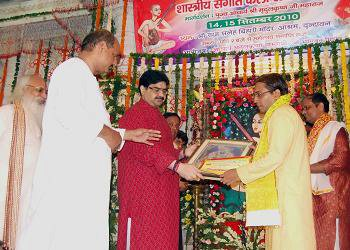
Braj Vrindavan Heritage Alliance
http://bvhalliance.blogspot.com
www.sudhir pandey.tabla masters.htm
Swami Haridas was a spiritual poet and classical musician. Credited with a large body of devotional compositions, especially in the Dhrupad style, he is also the founder of the Haridasi school of mysticism, still found today in North India. His work influenced both the classical music and the Bhakti movements of North India, especially those devoted to Krishna’s consort Radha. He is accounted a follower of the Nimbarka Sampradaya, the major Vaisnava tradition of exclusive devotion to Radha-Krishna. He was the disciple of Purandara Dasa and the teacher of Tansen. Read More: > HERE <
Vrindavan (Hindi: वृन्दावन)( pronunciation (help·info)) (alternately spelled Vrindaban, Brindavan, Brindavana, or Brundavan) also known as Vraj (as it lies in the Braj region) is a town in the Mathura district of Uttar Pradesh, India. It is the site of an ancient forest which is the region where Lord Krishna spent his childhood days. The town is about 15 km away from Mathura, the city of Lord Krishna’s birthplace, near the Agra-Delhi highway. The town hosts hundreds of temples dedicated to the worship of Radha and Krishna and is considered sacred by a number of religious traditions such as Gaudiya Vaishnavism, Vaishnavism, and Hinduism in general. It is nicknamed „City of Widows“ after the large population of abandoned widows who seek refuge here. Read More: > HERE <
Swami Haridas was a multi faceted personality. Primarily we know him as the saint who realized God through the route of nad brahma sadhna i.e. praying continuously in music. He not only composed a large number of poems (pad) but also started and perfected newer raags in classical music to sing the same. He realized God in the form of Shri Bankey Bihari, started the tradition of and initiated his disciples into rasopasna bhakti. He is also known as Adya Acharya of Raas Leela tradition. His birthday, which falls on Radha Ashtami day, is celebrated as a very special day in the temple, in Nidhivan and in Vrindavan.
Nidhivan as well as temple, both are decorated tastefully with flowers, flags and hangings. We have regular darshan at both places in the morning. In afternoon, around 4:30 PM, Raas Leela is staged in the courtyard of the temple. It is worthwhile to note, it is only once in the whole year on this day, that Raas Leela is performed in the temple.
Swami Haridas Sangit Samaroh Festival – Eminent Musician His Holiness Swami D. R. Parvatikar Veena Maharaj wanted to establish a yearly music Festival a international level at Vrindaban India in glorious memory of great musician Saint Shri Swami Haridas (Guru of Tansen ). Several music devotees and Artist appreciated this thinking of Veena Maharaj and Shri Swami Haridas Seva Samiti established by him in 1964 and every year Swami Haridas Sangit Samaroh started on Bihar Panchami, the appearance day of Shri Thakur Bankey Behariji.
After some period Shri Gopal Goswami taken up to organize the festival in Vrindaban, Delhi and Mumbai on the occasion of Radha-Astthami and managed many years. Gopal Goswami also organized the festival for few years. Prior to that Saint Shri Paad Baba of Vrindaban organized this music festival. This of Radha-Asthmi Atul Krshna Goswami organized it three days in Saneh Bihari Temple in Vrindaban.
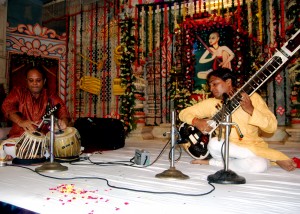
Swami Haridas Sangit Samaroh in the stage of famous Senior Artists of music field. Pt. Ravi Shankar, Ali Akbar, Bhim Sen Joshi, Bismillah Khan, Vilayat Khan, Gopikrishna, Sitara Devi, Kishori Amonkar, Ramchaturmalik and all of maximum famous artists have already been participated ith devotion to Swami Haridas ji. In view of the chain, this year also famous artists been invited.
Maestro Dr. Acharya Trigunateet Jaimini presented excellent performance on Sitar with beautiful accompany of Tabla player Sudhir Pandey from Delhi India who has quality experience of accompany with great masters Nikhil Banerji, Jasraj, Vilayat Khan & other Indian classical masters. Dr. Jaimini (Disciple of Swami D. R. Parvatikar) always get remarkable appreciations from the intellectual audience. His artistic talency holding over since two decades.
Dr. Jaimini & Sudhir Pandey also awarded Shastriya Kala Ratna Award in Swami Haridas Sangit Samaroh Festival. Coordinator Anup Sharma & Devendra Sharma told that He Specially invited Sudhir Pandey Tabla Player from Delhi to accompany with Dr. Jaimini for best presentation to the audience was thankful to Acharya Jaimini for his valuable participation in the programme.
Article by Ratnambara Sharma
writer Art & Culture
email – artcolour@rediffmail.com
mob. 91 9410226334
- Meet UNESCO World Heritage, friends, fans at fb <
- Meet Support UN Resolution on the Right to Water <
- Meet International Year of Biodiversity, friends, herbal fans at fb <
- Meet International Rivers, friends fans at fb <
- Meet IAIA – International Association for Impact Assessment at fb <
- Even like Yamuna the largest water distribution of Ganga, also Xingu River for Amazonas the consequences about non enviromental assessment creating negativ enviromental impacts, loss of biodiversity and cultural heritage. Scientists round the globe sounding Alarm about the freshwater qualities and Rivers.
Coming Famine – Training for Development
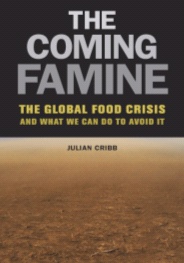
The Millennium Development Goals (MDGs) „are the most broadly supported, comprehensive and specific development goals the world has ever agreed upon. These eight time-bound goals provide concrete, numerical benchmarks for tackling extreme poverty in its many dimensions. They include goals and targets on income poverty, hunger, maternal and child mortality, disease, inadequate shelter, gender inequality, environmental degradation and the Global Partnership for Development. „Adopted by world leaders in the year 2000 and set to be achieved by 2015, the MDGs are both global and local, tailored by each country to suit specific development needs. They provide a framework for the entire international community to work together towards a common end – making sure that human development reaches everyone, everywhere. If these goals are achieved, world poverty will be cut by half, tens of millions of lives will be saved, and billions more people will have the opportunity to benefit from the global economy.“ Read More click HERE
COP16 will be the sixteenth Conference of the Parties (COP) under the United Nations Framework Convention on Climate Change (UNFCCC). The conference will be held in Mexico between November 29 and December 10, 2010. Read More: click HERE
A famine is a widespread scarcity of food that may apply to any faunal species. This phenomenon is usually accompanied by regional malnutrition, starvation, epidemic, and increased mortality. Long term measures include investment in modern agriculture in places that lack them, such as fertilizers and irrigation, which largely eradicated hunger in the developed world. However, World Bank strictures restrict government subsidies for farmers and the spread of fertilizer use is hampered by some environmental groups . Read More: click HERE
The coming famine: risks and solutions for global food security – Growing scarcities of water, land, oil and nutrients will combine with climate change to create a serious threat to global food security in coming decades. These could result in major regional famines, wars and refugee crises. Julian Cribb warns:
In The Coming Famine, Julian Cribb lays out a vivid picture of impending planetary crisis–a global food shortage that threatens to hit by mid-century–that would dwarf any in our previous experience. Cribb’s comprehensive assessment describes a dangerous confluence of shortages–of water, land, energy, technology, and knowledge–combined with the increased demand created by population and economic growth.
Writing in brisk, accessible prose, Cribb explains how the food system interacts with the environment and with armed conflict, poverty, and other societal factors. He shows how high food prices and regional shortages are already sending shockwaves into the international community. But, far from outlining a doomsday scenario, The Coming Famine offers a strong and positive call to action, exploring the greatest issue of our age and providing practical suggestions for addressing each of the major challenges it raises.
“The Coming Famine” will be published by the University of California Press and CSIRO Publishing in August 2010. It was supported by the Crawford Fund and Land & Water Australia.
www.EndPoverty2015.org www.standagainstpoverty.org
End poverty by 2015. This is the historic promise 189 world leaders made at the United Nations Millennium Summit in 2000 when they signed onto the Millennium Declaration and agreed to meet the Millennium Development Goals (MDGs). The MDGs are an eight-point road map with measurable targets and clear deadlines for improving the lives of the world’s poorest people. World leaders have agreed to achieve the MDGs by 2015.
The United Nations Millennium Campaign supports and inspires people from around the world to take action in support of the Millennium Development Goals.
Join the UN Millennium Campaign and be part of the generation that puts an end to poverty.
Abū Ibn SÄ�nÄ� – Medieval Medicine & Heritage
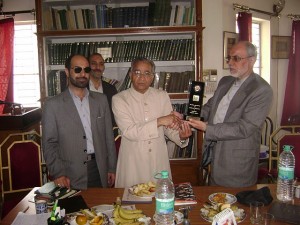
www.beruni.fan.uz www.muslimheritage.com
Ibn Sina Academy of Medieval Medicine and Sciences (IAMMS) (Urdu: ابن سینا اکا ڈ می آف میڈ یول میڈ یسین اینڈ سائنسیز) is one of the Indian NGOs, which is registered under the Indian Trusts Act, 1882. Mohammad Hamid Ansari, former vice-chancellor of Aligarh Muslim University, Aligarh, formally inaugurated it on April 21, 2001. Department of AYUSH, Ministry of Health and Family Welfare, Government of India gave accreditation to the academy in 2004 and promoted it as ‚centre of excellence‘ in 2008. Membership of the academy is open to anyone who has an interest in the academy’s activities particularly on history of medicine and history of science.The founder president is Hakim Syed Zillur Rahman. Read More: >HERE<
Unani Medicine or Yunani Medicine (pronounced /juːˈnɑːni/; YūnÄ�nÄ� in Arabic, Urdu, Bengali, Persian, Pashtu ) means „Greek“, also called „Unani-tibb“ is a form of traditional medicine widely practiced in India and Indian subcontinent. It refers to a tradition of Graeco-Arabic medicine, which is based on the teachings of Greek physician Hippocrates, and Roman physician Galen, and developed in to an elaborate medical System by Arab and Persian physicians, such as Rhazes, Avicenna (Ibn Sena), Al-Zahrawi , Ibn Nafis. Unani medicine is based around the concepts of the four humours: Phlegm (Balgham), Blood (Dam), Yellow bile (ṢafrÄ�‘) and Black bile (SaudÄ�‘). Read More: > HERE < The Unani Medicine is a traditional medicine and part of the trio Indian medicines – ayurveda, siddha and unani.
Ibnsina Academy of Medieval Medicine and Sciences – Abū AlÄ� al-Husayn ibn AbdullÄ�h ibn SÄ�nÄ� (Avicenna) is a well-known personality among the physicians of Unani medicine and scientists of physical sciences since medieval times. To commemorate and to institutionalize an academy named after him, Ibn Sina Academy of Medieval Medicine & Sciences, was founded on March 1, 2000. The Academy has been registered under Indian Trusts Act, 1882 on August 14, 2000. Mr. M. Hamid Ansari, Vice-chancellor of Aligarh Muslim University, Aligarh formally inaugurated it, on April 20, 2001. Department of AYUSH, Ministry of Health & Family Welfare, Govt. of India gave accreditation to the academy in 2004. The Academy is now a non-governmental, non-political and non-profit organization with multiple aims and objectives.
The Idea of the Formation of the Academy – There is a consensus amongst researchers of the history of medicine & sciences that early Arab, Muslim physicians and scientists had played a very important role in the development of natural and medical sciences during the renaissance of Islamic civilization, which spanned over eight centuries. This was achieved through translating earlier medical and scientific sources and developing then known sciences in the light of their clinical and scientific expertise.
Despite the above fact, it is well-known that the full potential of the Islamic medical and scientific particularly, heritage has not been investigated exhaustively to-date its basic role and importance in the development of modern medicine and its effect on the European Renaissance. Most of the manuscripts of Islamic medicine are lying unutilized on the shelves of private and some public libraries around the world and only few have been studied comprehensively. In the light of this, a number of physicians, scientists, scholars and historians are called for reviving this heritage on a national level. This is to be achieved through organization and teamwork.
And this is how the idea to found the Ibn Sina Academy of Medieval Medicine & Sciences (IAMMS) emerged. The first meeting of the Academy was held on March 5, 2000 in Aligarh (India) and was chaired by Professor (Hakim) Syed Zillur Rahman, president of IAMMS. A number of physicians and historians attended this meeting. The second meeting of the Academy was held on April 8, 2001 in Aligarh, when the By-Laws were discussed and approved.
It was also decided that Aligarh would be the permanent location of the Academy and it would operate as a normal registered trust as well. Membership of the society is open to everyone who has an interest in or would like to contribute by studying the History of Islamic Medicine and Sciences. The Academy looks forward to receiving support and help from all scholars and researchers in India and all over the world.
The Institute of Manuscripts of the Azerbaijan Academy of Sciences is a center for collecting, systematizing, storing and publishing medieval manuscripts. It currently includes about 40,000 documents including 11 000 manuscripts, in languages that include Azeri, Turkish, Uzbek, Persian and Arabic. These texts help us understand what Azerbaijanis from the Middle Ages thought about medicine, astronomy, mathematics, poetry, philosophy, law, history and geography.
The basis for the Institute was laid in 1924, when the first all-Azerbaijan Regional Congress was held in Baku. The Congress decided to organize a scientific library with a special department dedicated to ancient manuscripts and rare books. At first, this library was part of the Investigation Society of Azerbaijan; then it became attached to the Nizami Institute of Literature. In 1955 the Manuscript Department became the Independent Center of Scientific Research. Later, its name was changed to the Institute of Manuscripts.
Many of the ancient manuscripts found at the Institute came from the private collections of Azerbaijan’s most prominent 19th- and early 20th-century thinkers, including Abbasgulu agha Bakikhanov, Mirza Fatali Akhundov, Abdulgani Afandi Khalisagarizada, Husein Afandi Gaibov, Bahman Mirza Gajar and Mir Mohsun Navvab.
It continues to collect manuscripts, rare books and historical documents from all over Azerbaijan. The Institute is located in the former Alexandrian Russian Muslim Female Boarding School, which was built by Haji Zeynalabdin Taghiyev between 1898 and 1901. This was the first girl’s school in the Muslim East. The building was designed by Polish architect Joseph V. Goslavski (1865-1904), who also designed Baku’s City Hall and Taghiyev’s private residence, which now serves as the Taghiyev Museum housing the National History Museum collection.
In 1918, when Azerbaijan became independent, Taghiyev gave the building to the government of Azerbaijan to be used for ministers‘ offices. In 1920, after the Red Army invaded Azerbaijan, the Bolsheviks turned the building into the headquarters for the Worker, Peasant and Soldier Deputies. After that, it housed the Presidium of the Supreme Soviet of the Azerbaijan Republic (the governing body of Parliament). Since 1950, the building has housed what is now called the Institute of Manuscripts.
Medical Manuscripts – Among the carefully preserved books on natural sciences there are numerous sources on medicine and pharmacy in Oriental languages. The oldest of them dates back to the 9th century, the latest to the 20th. By the way, the Institute treasures one of the oldest hand-written copies of Canon of Medicine by great Ibn Sina (Avicenna) as well as other valuable works on medicine and pharmacy, including manuscripts of works by such medieval authors as Ali bin Abbas (10th century), Muwaffag al-Harawi (10th century), Isa ar-Ragi (10th century), Mahmud bin Ilyas (13th century), Yusif bin Ismail Khoyi (13-14th centuries), Zeyn al-Abidin Attar (15th century), Yusif bin Muhammad Harawi (15-16th centuries), Sultan Ali Khorasani (16th centurys), Sayyid Muhammad Mu’min (17th century), etc.
In order to find out the total number of manuscripts on medicine and pharmacy the funds and catalogs of the Institute have been examined by Prof. Farid Alakbarli. It has been revealed that the Institute’s collection includes 390 medieval manuscripts and 27 printed books on medicine and pharmacognosy written in the following languages: Persian – 222 manuscripts, Turkic (Old Azeri and Old Turkish) – 71 manuscripts, and Arabic – 70 manuscripts.
By the way, the Institute treasures one of the oldest hand-written copies of Canon of Medicine by great Ibn Sina (Avicenna) as well as other valuable works on medicine and pharmacy, including manuscripts of works by such medieval authors as Ali bin Abbas (10th century), Muwaffag al-Harawi (10th century), Isa ar-Ragi (…10th century), Mahmud bin Ilyas (13th century), Yusif bin Ismail Khoyi (13-14th centuries), Zeyn al-Abidin Attar (15th century), Yusif bin Muhammad Harawi (15-16th centuries), Sultan Ali Khorasani (16th centurys), Sayyid Muhammad Mu’min (17th century), etc.
A brief history of Islamic Medicine illustrating how advanced the Islamic World was compared to the West in the Middle Ages. / BBC – Islam and Science 3: The Power of Doubt 1/6 – العلم في الاسلام
The Abu Raihan Biruni Institute of Oriental Studies of the Academy of Science of the Republic of Uzbekistan was established in 1943 on the foundations of the Oriental Department of the Alishir Navai“i State Public Library. Until 1950 it was called the Institute for the Study of Oriental Manuscripts, and after 1950, considering the range of its scholarly directions, it was renamed the Oriental Studies Institute.
Materials in the collection include works written in Uzbek, Arabic, Persian, Tajik, Urdu, Pasto, Azeri, Ottoman Turkish, Tatar, Turkmen, Uighur and other languages. These materials encompass the fields of history, literature, philosophy, law, astronomy, physics, chemistry, medicine, pharmacology, language, geography, music, mathematics, mineralogy, agriculture, the figurative arts, and so on.
At the present time the manuscript collection contains 25,261 volumes. Many of them are miscellanies, where one codex contains diverse treatises. Thus there are far more treatises included in the collection than represented by the number of volumes alone. The Institute“s collection of lithographed and printed books amounts to about 39,300 volumes. They have important historical meaning for the study of history in Central Asia, its neighboring states “ Turkey, Iran, Afghanistan, Pakistan, India, China and Arab countries “ and also for the study of the political, economic, diplomatic and cultural links among them.
The collection has many manuscripts about the history of Islam, the Islamic sciences, and Sufism, written in Arabic, Persian, and old Uzbek and dating from the ninth to the nineteenth centuries. Among the manuscripts are early examples of the Qur“an, which date from the ninth century and employ the Kufic script. In addition, the collection holds rare copies of the Qur“an written at various times employing the Naskh script in artistic ways.
The Institute has a distinctive collection of archival documents that chronologically encompass a thousand-year period. The oldest document is from the tenth century, and the most recent is from the twentieth century. In particularly large quantity are documents compiled in the Bukharan, Khivan and Qoqand khanates. At the present time the Institute studies and publishes these documents.
- www.amu.ac.in Alligarh Muslim University
- Voices from the Ages – Baku’s Institute of Manuscripts <
- http://aligarhmovement.com/aligarians/hakim_zillur_rahman <
- Abu Raihan Biruni Institute of Oriental Studies <
- AVICENNA, UNANI MEDICINE & MATERIA MEDICA <
- ISLAMIC PLANT MEDICINE AND HISTORY <
- IRCICA – Muslim Calligraphy, Heritage <
- ACCESS TO MEDICINE´s PROJECT:
- http://en.wikipedia.org/wiki/Science_in_medieval_Islam
- www.essentialaction.org/access/ , http://standagainstpoverty.org/
- Meet AVICENNA, studies, friends, fans at fb <
- Meet KARKHANA ZINDA TILISMATH, Unani Medicine, friends, studies at fb <
- Meet Islamic Medicine “The Cure for Every Disease”, studies, friends at fb <
- Meet UNESCO World Heritage, friends, fans at fb <
- Meet the Oakland Institute, friends, fans, at fb <
- Meet International Year of Biodiversity, friends, herbal fans at fb <
- Meet United Nations Millennium Campaign, friends, fans at fb <